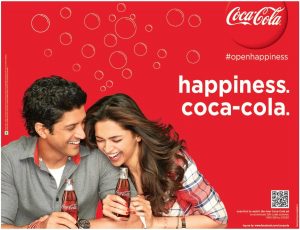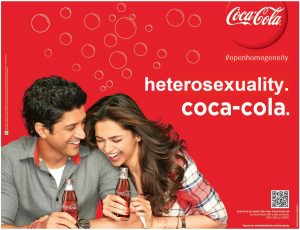
The Coca-Cola Corporation is one of the largest global advertisers. Their most iconic product, coca-cola itself, is readily available in over 200 countries around the world. And though this international market remains diverse in many ways, the advertising strategies employed by Coca-Cola seem to remain quite consistent. The signature ‘Coca-Cola Red’ and bottle-cap logo are almost always visible, as is an especially dewy and freshly cracked bottle of coca-cola. Besides their chilled appearance, the bottles are normally full, ready to be raised for that first sweet sip. Every coca-cola advertisement promises the perfect coke experience many of us have previously shared, that refreshing and unique flavor that has always proved somewhat addictive – but never disappoints.
Another marketing strategy remains common to coca-cola advertisements, though it may seem less obvious. Among the happy, smiling faces of coke drinkers are those who appear to conform to societal heteronormativity. Whether the advertisement appears in print or on television, heterosexual couples are consistently shown holding a coke beverage and doing what the ad suggests – opening happiness. All of these stereotypically coca-cola advertisement qualities are apparent in the above example. The uniformity and simplicity that is repeated in coca-cola ads such as this presents an uncomplicated message to the potential audience. Of course, as is common to all marketing, the goal of the company is to market a lifestyle or an ideal rather than simply a product, and this is no different in Coca-Cola’s case. By showing couples with conventional sexuality Coca-Cola is ensuring that it will not offend any potential consumers who are offended by homosexuality, while at the same time nothing appears amiss to a consumer of a different sexuality because they are continually presented with images of happy heterosexual couples wherever they go.
The bottom line of these heterocentric advertisements is profit. The Coca-Cola company, along with countless others, have less to gain from adopting a socially and politically progressive message than maintaining an apparently neutral one. Especially given the age-old coca-cola versus pepsi battle, neither company wants to give their consumers a reason to prefer one brand over the other, and so the public placation persists. But how damaging can an advertisement like this really be? After all, isn’t it an uncomplicated expression of a pleasant emotion – happiness? In what follows below I will address the reasons behind why I find this practice of perpetual heterosexuality a problem.

As I mentioned above, Coca-Cola is one of the largest advertisers in the world. Wherever you go, coca-cola billboards, posters, and commercials confront you. And as is becoming clearer, ubiquitous advertising can have damaging effects on large populations. The negative effects experienced largely by women in regard to unrealistic and altered body images is continually being explored. In many ways, advertisements such as this work in a similar way.
I would argue that being presented with countless images of happy cisgender heterosexuality has a significant impact on individuals with unconventional sexuality or gender identities. This is likely especially true when one considers the case of children or young people who are coming to terms with their potential ‘differences.’ Imagine, how normal would it feel to look around the world and see no images of love which resemble your idea of love? Specifically in the case of this advertisement, which explicitly refers to this heterosexual scenario as ‘happiness’ – what if this doesn’t suit an individuals notion of what happiness might be?
This case is all the more powerful when one considers coca-cola. In a brand which has such global and instant recognition the messages they convey have wide-reaching and significant impact. The heterosexuality they choose to maintain in their imagery reinforces the idea that any potential difference is an abnormality. Further, because Coca-Cola has chosen to associate their product with a lifestyle and an ideal rather than simply a carbonated beverage, the implications go deeper still. Happiness is not only with a bottle of coke, but it is with a man and a woman. The ideals selected by the corporation which coke is meant to exemplify – ‘americanness’, happiness, simplicity, joy, tradition, celebration – all dwell within the realm of heterosexuality in a process of perpetual repetition. This mold is slowly being broken within the advertising world however, with certain companies releasing advertisements with same-sex couples. Though, until behemoth corporations like Coca-Cola begin sharing images of couples outside of heterosexual homogeneity, individuals of sexual and gender difference cannot begin the process of true societal integration.